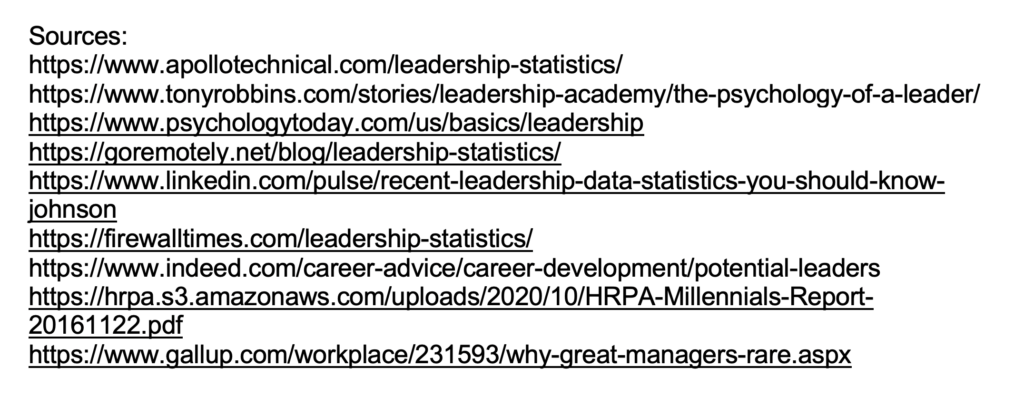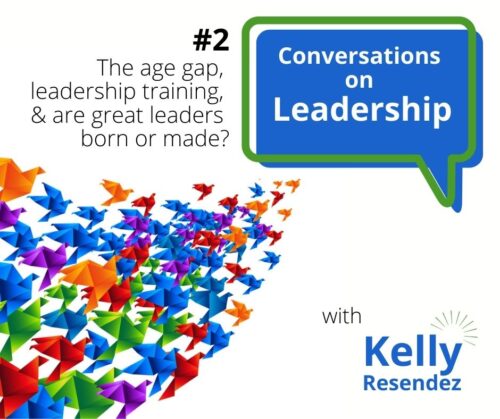Conversations on Leadership w/ Kelly Resendez: #2 The age gap, leadership training, and are great leaders born or made?

Conversations on Leadership w/ Kelly Resendez: #1 The truth, leadership development, and identifying potential
December 18, 2021
Inside the Great Resignation
February 1, 2022Conversations on Leadership w/ Kelly Resendez: #2 The age gap, leadership training, and are great leaders born or made?
“Before you are a leader, success is all about growing yourself. When you become a leader, success is all about growing others.”
—Jack Welch
There are many definitions of leadership, as well as checklists that attempt to define what makes a good (or bad) leader.
And yet, a crystal-clear concept of leadership still alludes us in many facets of life, from relationships to self-achievement and certainly at work.
So, I decided to create a series of blog posts for you, each one taking a few smaller – but just as important – parts of the leadership phenomenon and examining them thoroughly before giving you some sound advice.
Last month, we delved into three important aspects of leadership: the stakes for businesses and companies, leadership development, and identifying potential leaders.
Today, we’re going to continue our deep dive into leadership by talking about the age gap in leadership positions, leadership training, and answering the critical question, are good leaders made or born?
I hope you enjoy it and get something substantive to take away – and I’m already looking forward to our next conversation!
The age gap and Millennials in leadership
One of the biggest challenges to U.S. business and commerce over the next ten years is the exodus of experienced supervisors, managers, and leaders from the workforce.
This issue stems from the changing demographic of the American (as well as global) workforce. Put simply, there is a massive swell of younger workers while, at the same time, older generations are aging-out and retiring from their well-entrenched positions.
In fact, by 2025, 75% of the U.S. workforce will consist of millennials, a trend that’s rapidly accelerating due to pandemic-era early retirements and Boomers walking away from their leadership roles.
Why does the fact that millennials will make up about three-quarters of the workforce by 2025 create such a pressing challenge? In surveys, 77% of that age cohort described their company’s leadership development as “weak,” and 63% said their leadership skills were not being developed. Few firms get sterling reviews when it comes to developing young leaders.
Add it all up, and there’s no doubt that we’re facing a profound void in leadership, in large part since 10,000 Baby Boomers are retiring every single day.
To that point, 55% of CEOs say that developing the next generation of leaders is their #1 challenge and 47% predict a leadership shortage in the near future.
Leadership training
As we covered in our last blog, developing leaders is an incredibly vibrant industry, adding up to $165.3 billion in the U.S. and Canada in 2020.
However, the capacity to properly train our emerging leaders still falls short. Too often, strong or dominant personalities or recognition dictate who ends up in the C-suite or management positions, but the skills to lead others to success are still lacking. According to industry surveys, only 14% of CEOs have the leadership talent they need to put their company on a path to survive and flourish.
Likewise, 30% of Fortune 500 companies don’t create effective internal leadership development programs at all. That’s nearly one in three major firms that fall flat when it comes to identifying and fostering the people who will be leading their organizations in the not-so-distant future.
To that point, an alarming 42% of managers develop their leadership methods by observation alone instead of benefiting from formal training.
Looking at it from the perspective of age and the emerging demographic chasm, 63% of Millennial workers surveyed said that their company wasn’t developing their leadership capabilities or encouraging their talents. Even more profound, 77% called their company’s leadership training “weak,” a telling indictment of our collective capacity to train and develop tomorrow’s leaders.
Are great leaders born or made?
We often embrace the archetype of the natural leader, who appears to possess the inherent qualities to motivate men and women in their DNA. However, that’s far from the reality.
Instead, it’s estimated that only 10% of people have natural leadership ability. That’s about one in ten who have the talent to lead people to success without formal or conscious training. And according to Gallup polls, another 20% of the population have some sort of talent or potential for leadership, which can be brought out with proper development.
Far from that myth of the bold, born leader, our CEOs, VPs, board members, and managers are usually nurtured into the role (or should be).
Of course, it’s possible that someone has some innate leadership potential or talent, but that only emerges and is honed by training as well as experience.
Add it all up, and researchers estimate that the quality of effective leadership is about one-third naturally-born and two-thirds made. That’s encouraging for those who are looking to climb the corporate ladder but don’t feel strongly that their natural gifts alone can get them there.
So, in our next conversation, we’ll talk about the important qualities and personality traits – both born and developed – for leadership.
Until then, lead on!
-Kelly
***





